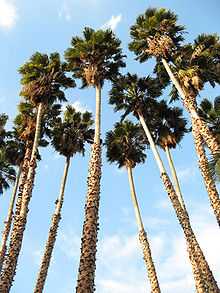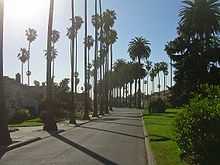Washingtonia robusta
| Washingtonia robusta | |
|---|---|
 | |
| Mexican Washingtonias planted in Los Angeles County Arboretum and Botanic Garden | |
| Scientific classification | |
| Kingdom: | Plantae |
| (unranked): | Angiosperms |
| (unranked): | Monocots |
| (unranked): | Commelinids |
| Order: | Arecales |
| Family: | Arecaceae |
| Genus: | Washingtonia |
| Species: | W. robusta |
| Binomial name | |
| Washingtonia robusta H.Wendl.[1] | |
| Synonyms[2] | |
| |
Washingtonia robusta (Mexican Fan Palm or Mexican Washingtonia) is a palm tree native to western Sonora and Baja California in northwestern Mexico. It is reportedly naturalized in Spain, the Canary Islands, Réunion, New Zealand, Hawaii, Florida and California.[3]
Description
Washingtonia robusta grows to 25 m (82 ft) tall, rarely up to 30 m (98 ft). The leaves have a petiole up to 1 m (3.3 ft) long, and a palmate fan of leaflets up to 1 m long. The inflorescence is up to 3 m (9.8 ft) long, with numerous small pale orange-pink flowers. The fruit is a spherical, blue-black drupe, 6–8 mm (0.24–0.31 in) diameter; it is edible, though thin-fleshed.
Cultivation and uses
Like the closely related Washingtonia filifera (California Fan Palm), it is grown as an ornamental tree. Although very similar, the Mexican Washingtonia has a narrower trunk (which is typically somewhat wider at the base), and grows slightly faster and taller; it is also somewhat less cold hardy than the California Washingtonia, hardy to about −7 °C (19 °F). The Palm was originally introduced to Los Angeles to beautify the town for the 1932 Summer Olympics. Many Palms planted then in Los Angeles are near the end of their natural lives and are fully mature. Most of these trees are not being replaced with other Mexican Washingtonia Palms but with other full-spread trees like oak trees and sycamores which trap more air pollution and provide more shade. From Los Angeles the Palms began to spread to other areas in the U.S.A.. Unlike Washingtonia filifera, which has been cultivated as far north as Oklahoma and Southwestern Utah, the Mexican fan palm can be grown mainly around areas of the southwestern United States, such as California and the coast of Oregon, Arizona, Southern Nevada, and New Mexico. It may also be seen along the Gulf Coast from Texas to Florida and may also be found in coastal Georgia and South Carolina.
Washingtonia × filibusta is a hybrid of W. robusta and W. filifera and has intermediate characteristics of the two parents, especially greater tolerance of wet cold.[4]
Gallery
-

Flowering palm in Chandler, Arizona
-
Infructescence
-
Inflorescence
-
Species in Venice Beach, California
-

Washingtonia robusta and Canary Island Date Palms are commonly seen lining many streets throughout San Jose, California
-

Species line Santa Clara Street in San Jose, California
-

Oldest palms in Los Angeles, planted circa 1875.
References
| Wikimedia Commons has media related to Washingtonia robusta. |
| Wikispecies has information related to: Washingtonia robusta |
- ↑ "Washingtonia robusta H. Wendl.". Germplasm Resources Information Network. United States Department of Agriculture. 2010-03-16. Retrieved 2010-07-17.
- ↑ The Plant List
- ↑ Kew World Checklist of Selected Plant Families,Washingtonia robusta
- ↑ Riffle, Robert Lee (2008). Timber Press Pocket Guide to Palms. Timber Press Pocket Guides. Portland, Oregon: Timber Press. p. 224. ISBN 978-0-88192-776-4.



